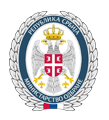13.02.2019.
The book “Field marshals and field marshal's flags” presented
At the Atrium of the Central Military Club, today, a new book by Professor Radoš Ljušić, entitled “Field marshals and field marshal's flags – Military organisation of the insurgent Serbia (1804 - 1815)”, was presented. Apart from the author, speakers at the promotion were Dragana Marković, on behalf of Odbrana Media Centre, and :Prof. Suzana Rajić and Radomir Popović, PhD.
 At the beginning, Dragana Marković said that this monograph, published by Odbrana Media Centre, filled a significant emptiness about the Serbian Revolution, and it is notably about the military structure of the insurgent Serbia and field marshal's flags. The period covered by this study is seen by the author as a unique whole, so that the war period of the Serbian revolution is at the same time the chronological framework of this book.
At the beginning, Dragana Marković said that this monograph, published by Odbrana Media Centre, filled a significant emptiness about the Serbian Revolution, and it is notably about the military structure of the insurgent Serbia and field marshal's flags. The period covered by this study is seen by the author as a unique whole, so that the war period of the Serbian revolution is at the same time the chronological framework of this book.Although battles, field marshals, people's and regular army of insurgent Serbia in the First Serbian Uprising have been written much more about so far than those of the Second Serbian Uprising, only this monograph gives us a transparent and systematic insight into the military organization of Serbia from 1804 to 1815, as it is stated in the review by Radomir Popović published with the book, among other things.
Professor Suzana Rajić pointed out that the promotion of this book is the best introduction into marking the Statehood Day and an important reminder of the very foundation of the Serbian statehood. She underlined that without the knowledge found in this study, we cannot understand either the development of the Serbian statehood or the development of the most important institutions of Serbia of that time, without which even today's Serbia would not exist. Profesor Rajić concluded that this monograph is in line with monumental editions of our historical science.
 The reviewer of the monograph “Field marshals and field marshal's flags – Military organisation of the insurgent Serbia (1804 - 1815)”, Radomir Popović, PhD, emphasized that this study is actually the result of a long research of Serbian history, with a focus on the Serbian Revolution on which professor Ljušić is persisting in his work. He added that in addition to a detailed list of Serbian field marshals, this book has corrected some of the facts so far wrongly cited, giving the example of the previous division to the so-called big and small field marshals. Professor Popović concludes that Ljušić's study is actually guided by the opinion of Milorad Ekmečić that the Serbian Revolution is an “extract of Serbian history of XIX and XX century”, with the remark that its influence has been present until our days.
The reviewer of the monograph “Field marshals and field marshal's flags – Military organisation of the insurgent Serbia (1804 - 1815)”, Radomir Popović, PhD, emphasized that this study is actually the result of a long research of Serbian history, with a focus on the Serbian Revolution on which professor Ljušić is persisting in his work. He added that in addition to a detailed list of Serbian field marshals, this book has corrected some of the facts so far wrongly cited, giving the example of the previous division to the so-called big and small field marshals. Professor Popović concludes that Ljušić's study is actually guided by the opinion of Milorad Ekmečić that the Serbian Revolution is an “extract of Serbian history of XIX and XX century”, with the remark that its influence has been present until our days. Professor Radoš Ljušić, with gratitude to the publisher and his collaborators who helped him in collecting facsimiles for this book, adds that the military problem of the Serbian Revolution was present from the beginning in all the studies that have been published so far on this topic, but it is only now that it is separate from other themes and personalities that are in the foundation of the Serbian statehood. Ljušić emphasizes that the chapter about the military and civil authority of insurgent Serbia, which has not been mentioned in the Serbian historiography so far, is particularly important for him personally.
Professor Radoš Ljušić, with gratitude to the publisher and his collaborators who helped him in collecting facsimiles for this book, adds that the military problem of the Serbian Revolution was present from the beginning in all the studies that have been published so far on this topic, but it is only now that it is separate from other themes and personalities that are in the foundation of the Serbian statehood. Ljušić emphasizes that the chapter about the military and civil authority of insurgent Serbia, which has not been mentioned in the Serbian historiography so far, is particularly important for him personally.On behalf of the publisher, Dragana Marković adds that apart from the contents of this monograph, which was taken care of by Professor Ljušić, it also got its visual identity for which Aleksandra Dolović is credited.

